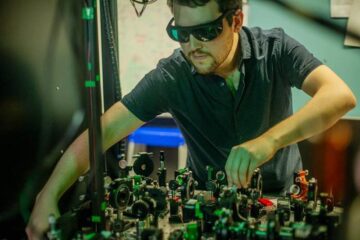Predicting the perfect predator

University of Illinois ecologist Adam Davis has created a computer model that in combination with quarantined research tests he believes will be able to predict the perfect predator — a pest that can be introduced into a forested area that will help reduce the garlic mustard population.
“The traditional method has been to release multiple agents into the environment and overwhelm the pest,” said Davis. “But with multiple introductions comes an increased likelihood that one of the agents will become invasive as well. So, what we’re trying to do is to figure out which one is the most likely to actually have an impact on garlic mustard (Alliaria petiolata) and release as few agents as possible.”
Davis is a member of the research team for USDA’s Invasive Weed Management Unit at the U of I. He has been working since 2004 on a project along with scientists at Michigan State, Cornell, and the Commonwealth Institute of Biological Control in Switzerland.
Davis’ computer model creates a simulation of the population dynamics of the pest species – its seed and growth cycle, stressors, etc. “Then you can introduce the biological control agents that you’re considering one at a time and see whether you can get away with just introducing one agent,” said Davis. “I collected data from field experiments and entered them into the computer model which then projects forward which agent will be most effective.”
The computer simulation was used to select a tiny weevil, about the size of an “o” in 12 point type. “There are actually several weevils that feed on garlic mustard back home in Europe, where it comes from,” said Davis. “This particular weevil that we’re looking at (Ceutorhynchus scrobicollis) feeds on the plant at several stages in its life cycle so it’s a much more effective agent than some of the other ones.”
What happens if the control agent also becomes an invasive species?
“A stringent battery of tests is performed on each biocontrol agent in quarantine before it is ever released. For example, garlic mustard is in the same family (Brassicaceae) as cabbage, so one test might be to only feed the weevil cabbage and see if it survives on it or can reproduce on it. If it does, then the possibility exists that it could move from the garlic mustard and threaten cabbage plants, which we don’t want to happen. But, this particular weevil has passed that test for a wide variety of plants.”
Davis said that there are different strategies for biological control. One strategy is inundative in which the control agent eats its way through the garlic mustard and then dies out itself because there isn’t anything left to support it. The other strategy is to introduce a natural enemy that will just bring the population down to a lower level and the plants and pests just continue to coexist. “The idea is that you reunite plants with a natural enemy from back home – which in garlic mustard’s case is Europe. In Switzerland garlic mustard and the weevil coexist and neither one is invasive.”
Garlic mustard was brought to the United States from Europe innocently in the 1870’s as a culinary herb but its natural enemy didn’t accompany it.
Davis says there are some concerns among ecologists about biological control because of the risk of negative effects on nontarget species. “But when you have invasive plant species covering very large acreages it’s almost impossible to manage by hand,” he said. “There are herbicides that will work on garlic mustard, but it infests millions of acres of forest and there’s no way you can get out there and spray all of that. And because garlic mustard has a really long-lived seed bank, in order to eradicate it, you’d have to hit it for about eight to ten years in a row.”
Pending approval from APHIS-PPQ (the species evaluation and quarantine arm of the USDA) the weevil is scheduled to be released into an infested forest later this year. Davis said that the beauty of using simulation models to guide biocontrol is that this approach can be adapted for use in controlling other invasive species, not just garlic mustard.
Media Contact
More Information:
http://www.uiuc.eduAll latest news from the category: Ecology, The Environment and Conservation
This complex theme deals primarily with interactions between organisms and the environmental factors that impact them, but to a greater extent between individual inanimate environmental factors.
innovations-report offers informative reports and articles on topics such as climate protection, landscape conservation, ecological systems, wildlife and nature parks and ecosystem efficiency and balance.
Newest articles

Combatting disruptive ‘noise’ in quantum communication
In a significant milestone for quantum communication technology, an experiment has demonstrated how networks can be leveraged to combat disruptive ‘noise’ in quantum communications. The international effort led by researchers…

Stretchable quantum dot display
Intrinsically stretchable quantum dot-based light-emitting diodes achieved record-breaking performance. A team of South Korean scientists led by Professor KIM Dae-Hyeong of the Center for Nanoparticle Research within the Institute for…

Internet can achieve quantum speed with light saved as sound
Researchers at the University of Copenhagen’s Niels Bohr Institute have developed a new way to create quantum memory: A small drum can store data sent with light in its sonic…





















